
- WML Tutorial
- WML - Home
- WML - Overview
- WML - Environment
- WML - Syntax
- WML - Elements
- WML - Comments
- WML - Variables
- WML - Formatting
- WML - Fonts
- WML - Images
- WML - Tables
- WML - Links
- WML - Tasks
- WML - Inputs
- WML - Submit Data
- WML - Server Scripts
- WML - Events
- WML - Timer
- WML - Template
- WML - DTD
- WML2 - Tutorial
- WML References
- WML - Entities
- WML - Tags Reference
- WML Tools
- WAP - Emulators
- WML - Validator
- WML Useful Resources
- WML - Quick Guide
- WML - Useful Resources
- WML - Discussion
WML - Quick Guide
WML - Overview
The topmost layer in the WAP (Wireless Application Protocol) architecture is made up of WAE (Wireless Application Environment), which consists of WML and WML scripting language.
WML stands for Wireless Markup Language
WML is an application of XML, which is defined in a document-type definition.
WML is based on HDML and is modified so that it can be compared with HTML.
WML takes care of the small screen and the low bandwidth of transmission.
WML is the markup language defined in the WAP specification.
WAP sites are written in WML, while web sites are written in HTML.
WML is very similar to HTML. Both of them use tags and are written in plain text format.
WML files have the extension ".wml". The MIME type of WML is "text/vnd.wap.wml".
WML supports client-side scripting. The scripting language supported is called WMLScript.
WML Versions:
WAP Forum has released a latest version WAP 2.0. The markup language defined in WAP 2.0 is XHTML Mobile Profile (MP). The WML MP is a subset of the XHTML. A style sheet called WCSS (WAP CSS) has been introduced alongwith XHTML MP. The WCSS is a subset of the CSS2.
Most of the new mobile phone models released are WAP 2.0-enabled. Because WAP 2.0 is backward compatible to WAP 1.x, WAP 2.0-enabled mobile devices can display both XHTML MP and WML documents.
WML 1.x is an earlier technology. However, that does not mean it is of no use, since a lot of wireless devices that only supports WML 1.x are still being used. Latest version of WML is 2.0 and it is created for backward compatibility purposes. So WAP site developers need not to worry about WML 2.0.
WML Decks and Cards:
A main difference between HTML and WML is that the basic unit of navigation in HTML is a page, while that in WML is a card. A WML file can contain multiple cards and they form a deck.
When a WML page is accessed from a mobile phone, all the cards in the page are downloaded from the WAP server. So if the user goes to another card of the same deck, the mobile browser does not have to send any requests to the server since the file that contains the deck is already stored in the wireless device.
You can put links, text, images, input fields, option boxes and many other elements in a card.
WML Program Structure:
Following is the basic structure of a WML program:
<?xml version="1.0"?> <!DOCTYPE wml PUBLIC "-//WAPFORUM//DTD WML 1.2//EN" "http://www.wapforum.org/DTD/wml12.dtd"> <wml> <card id="one" title="First Card"> <p> This is the first card in the deck </p> </card> <card id="two" title="Second Card"> <p> Ths is the second card in the deck </p> </card> </wml>
The first line of this text says that this is an XML document and the version is 1.0. The second line selects the document type and gives the URL of the document type definition (DTD).
One WML deck (i.e. page ) can have one or more cards as shown above. We will see complete details on WML document structure in subsequent chapter.
Unlike HTML 4.01 Transitional, text cannot be enclosed directly in the <card>...</card> tag pair. So you need to put a content inside <p>...</p> as shown above.
WAP Site Design Considerations:
Wireless devices are limited by the size of their displays and keypads. It's therefore very important to take this into account when designing a WAP Site.
While designing a WAP site you must ensure that you keep things simple and easy to use. You should always keep in mind that there are no standard microbrowser behaviors and that the data link may be relatively slow, at around 10Kbps. However, with GPRS, EDGE, and UMTS, this may not be the case for long, depending on where you are located.
The following are general design tips that you should keep in mind when designing a service:
Keep the WML decks and images to less than 1.5KB.
Keep text brief and meaningful, and as far as possible try to precode options to minimize the rather painful experience of user data entry.
Keep URLs brief and easy to recall.
Minimize menu levels to prevent users from getting lost and the system from slowing down.
Use standard layout tags such as <big> and <b>, and logically structure your information.
Don't go overboard with the use of graphics, as many target devices may not support them.
WML - Environment
To develop WAP applications, you will need the following:
A WAP enabled Web Server: You can enable your Apache or Microsoft IIS to serve all the WAP client request.
A WAP Gateway Simulator: This is required to interact to your WAP server.
A WAP Phone Simulator: This is required to test your WAP Pages and to show all the WAP pages.
You can write your WAP pages using the following languages:
- Wireless Markup Language(WML) to develop WAP application.
- WML Script to enhance the functionality of WAP application.
Configuring Web Server:
In normal web applications, MIME type is set to text/html, designating normal HTML code. Images, on the other hand, could be specified as image/gif or image/jpeg, for instance. With this content type specification, the web browser knows the data type that the web server returns.
To make your Apache WAP compatible, you have nothing to do very much. You simply need to add support for the MIME types and extensions listed below.
| File Extension | MIME type |
|---|---|
| WML (.wml) | text/vnd.wap.wml |
| WMLScript (.wmls) | text/vmd.wap.wmlscript |
| WMLScriptc (.wmlsx) | application/vnd.wap.wmlscriptc |
| WMLC (.wmlc) | application/vnd.wap.wmlc |
| WBMP (.wbmp) | image/vnd.wap.wbmp |
Configure Apache Web Server for WAP:
Assuming you have Apache Web server installed on your machine. So now we will tell you how to enable WAP functionality in your Apache web server.
So locate Apache's file httpd.conf which is usually in /etc/httpd/conf, and add the following lines to the file and restart the server:
AddType text/vnd.wap.wml .wml AddType text/vnd.wap.wmlscript .wmls AddType application/vnd.wap.wmlc .wmlc AddType application/vnd.wap.wmlscriptc .wmlsc AddType image/vnd.wap.wbmp .wbmp
In dynamic applications, the MIME type must be set on the fly, whereas in static WAP applications the web server must be configured appropriately.
Configure Microsoft IIS for WAP:
To configure a Microsoft IIS server to deliver WAP content, you need to perform the following:
- Open the Internet Service Manager console and expand the tree to view your Web site entry. You can add the WAP MIME types to a whole server or individual directories.
- Open the Properties dialog box by right-clicking the appropriate server or directory, then choose Properties from the menu.
- From the Properties dialog, choose the HTTP Headers tab, then select the File Types button at the bottom right.
- For each MIME type listed earlier in the above table, supply the extension with or without the dot (it will be automatically added for you), then click OK in the Properties dialog box to accept your changes.
Installing WAP Gateway Simulator:
There are many WAP Gateway Simulator available on the Internet so download any of them and install on your PC. You would need to run this gateway before starting WAP Mobile simulator.
WAP Gateway will take your request and will pass it to the Web Server and whatever response will be received from the Web server that will be passed to the Mobile Simulator.
You can download it from Nokia web site:
Nokia WAP Gateway simulator - Download Nokia WAP Gateway simulator.
Installing WAP Phone Simulator:
There are many WAP Simulator available on the Internet so download any of them and install on your PC which you will use as a WAP client. Here are popular links to download simulator:
Nokia WAP simulator - Download Nokia WAP simulator.
WinWAP simulator - Download WinWAP browser from their official website.
NOTE: If you have WAP enabled phone then you do not need to install this simulator. But while doing development it is more convenient and economic to use a simulator.
The WAP Model:
I am giving this section just for your reference, if you are not interested then you can skip this section.
The figure below shows the WAP programming model. Note the similarities with the Internet model. Without the WAP Gateway/Proxy the two models would have been practically identical.
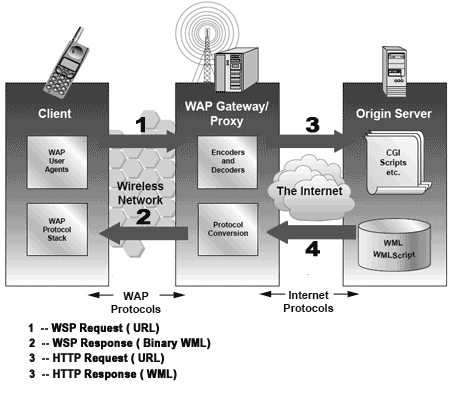
WAP Gateway/Proxy is the entity that connects the wireless domain with the Internet. You should make a note that the request that is sent from the wireless client to the WAP Gateway/Proxy uses the Wireless Session Protocol (WSP). In its essence, WSP is a binary version of HTTP.
A markup language - the Wireless Markup Language (WML) has been adapted to develop optimized WAP applications. In order to save valuable bandwidth in the wireless network, WML can be encoded into a compact binary format. Encoding WML is one of the tasks performed by the WAP Gateway/Proxy.
How WAP Model Works?
When it comes to actual use, WAP works like this:
The user selects an option on their mobile device that has a URL with Wireless Markup language (WML) content assigned to it.
The phone sends the URL request via the phone network to a WAP gateway, using the binary encoded WAP protocol.
The gateway translates this WAP request into a conventional HTTP request for the specified URL, and sends it on to the Internet.
The appropriate Web server picks up the HTTP request.
The server processes the request, just as it would any other request. If the URL refers to a static WML file, the server delivers it. If a CGI script is requested, it is processed and the content returned as usual.
The Web server adds the HTTP header to the WML content and returns it to the gateway.
The WAP gateway compiles the WML into binary form.
The gateway then sends the WML response back to the phone.
The phone receives the WML via the WAP protocol.
The micro-browser processes the WML and displays the content on the screen.
WML - Syntax
A WML program is typically divided into two parts: the document prolog and the body. Consider the following code:
Following is the basic structure of a WML program:
<?xml version="1.0"?> <!DOCTYPE wml PUBLIC "-//WAPFORUM//DTD WML 1.2//EN" "http://www.wapforum.org/DTD/wml12.dtd"> <wml> <card id="one" title="First Card"> <p> This is the first card in the deck </p> </card> <card id="two" title="Second Card"> <p> Ths is the second card in the deck </p> </card> </wml>
WML Document Prolog:
The first line of this text says that this is an XML document and the version is 1.0. The second line selects the document type and gives the URL of the document type definition (DTD). The DTD referenced is defined in WAP 1.2, but this header changes with the versions of the WML. The header must be copied exactly so that the tool kits automatically generate this prolog.
The prolog components are not WML elements and they should not be closed, i.e. you should not give them an end tag or finish them with />.
WML Document Body:
The body is enclosed within a <wml> </wml> tag pair. The body of a WML document can consist of one or more of the following:
Deck
Card
Content to be shown
Navigation instructions
Unlike HTML 4.01 Transitional, text cannot be enclosed directly in the <card>...</card> tag pair. So you need to put a content inside <p>...</p> as shown above.
Testing Your Program:
Put above code in a file called test.wml file, and put this WML file locally on your hard disk, then view it using an emulator.
This is by far the most efficient way of developing and testing WML files. Since your aim is, however, to develop a service that is going to be available to WAP phone users, you should upload your WML files onto a server once you have developed them locally and test them over a real Internet connection. As you start developing more complex WAP services, this is how you will identify and rectify performance problems, which could, if left alone, lose your site visitors.
In uploading the file test.wml to a server, you will be testing your WML emulator to see how it looks and behaves, and checking your Web server to see that it is set up correctly. Now start your emulator and use it to access the URL of test.wml. For example, the URL might look something like this:
http://websitename.com/wapstuff/test.wml
NOTE: Before accessing any URL, make sure WAP Gateway Simulator is running on your PC.
When you will download your WAP program, then you will see only first card at your mobile. Following is the output of the above example on Nokia Mobile Browser 4.0. This mobile supports horizontal scrolling. You can see the text off the screen by pressing the "Left" or "Right" button.
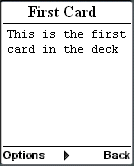
When you press right button, then second card will be visible as follows:
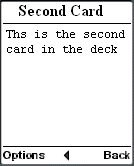
WML - Elements
WML is defined by a set of elements that specify all markup and structural information for a WML deck. Elements are identified by tags, which are each enclosed in a pair of angle brackets.
Unlike HTML, WML strictly adheres to the XML hierarchical structure, and thus, elements must contain a start tag; any content such as text and/or other elements; and an end tag. Elements have one of the following two structures:
<tag> content </tag> : This form is identical to HTML.
<tag />: This is used when an element cannot contain visible content or is empty, such as a line break. WML document's prolog part does not have any element which has closing element.
Following table lists the majority of valid elements. A complete detail of all these elements is given in WML Tags Reference.
Deck & Card Elements
| WML Elements | Purpose |
|---|---|
| <!--> | Defines a WML comment |
| <wml> | Defines a WML deck (WML root) |
| <head> | Defines head information |
| <meta> | Defines meta information |
| <card> | Defines a card in a deck |
| <access> | Defines information about the access control of a deck |
| <template> | Defines a code template for all the cards in a deck |
Text Elements
| WML Elements | Purpose |
|---|---|
| <br> | Defines a line break |
| <p> | Defines a paragraph |
| <table> | Defines a table |
| <td> | Defines a table cell (table data) |
| <tr> | Defines a table row |
| <pre> | Defines preformatted text |
Text Formatting Tags
| WML Elements | Purpose |
|---|---|
| <b> | Defines bold text |
| <big> | Defines big text |
| <em> | Defines emphasized text |
| <i> | Defines italic text |
| <small> | Defines small text |
| <strong> | Defines strong text |
| <u> | Defines underlined text |
Image Elements
| WML Elements | Purpose |
|---|---|
| <img> | Defines an image |
Anchor Elements
| WML Elements | Purpose |
|---|---|
| <a> | Defines an anchor |
| <anchor> | Defines an anchor |
Event Elements
| WML Elements | Purpose |
|---|---|
| <do> | Defines a do event handler |
| <onevent> | Defines an onevent event handler |
| <postfield> | Defines a postfield event handler |
| <ontimer> | Defines an ontimer event handler |
| <onenterforward> | Defines an onenterforward handler |
| <onenterbackward> | Defines an onenterbackward handler |
| <onpick> | Defines an onpick event handler |
Task Elements
| WML Elements | Purpose |
|---|---|
| <go> | Represents the action of switching to a new card |
| <noop> | Says that nothing should be done |
| <prev> | Represents the action of going back to the previous card |
| <refresh> | Refreshes some specified card variables. |
Input Elements
| WML Elements | Purpose |
|---|---|
| <input> | Defines an input field |
| <select> | Defines a select group |
| <option> | Defines an option in a selectable list |
| <fieldset> | Defines a set of input fields |
| <optgroup> | Defines an option group in a selectable list |
Variable Elements
| WML Elements | Purpose |
|---|---|
| <setvar> | Defines and sets a variable |
| <timer> | Defines a timer |
WML - Comments
As with most programming languages, WML also provides a means of placing comment text within the code.
Comments are used by developers as a means of documenting programming decisions within the code to allow for easier code maintenance.
WML comments use the same format as HTML comments and use the following syntax:
<!-- This will be assumed as a comment -->
A multiline comment can be given as follows:
<!-- This is a multi-line
comment -->
The WML author can use comments anywhere, and they are not displayed to the user by the user agent. Some emulators may complain if comments are placed before the XML prolog.
Note that comments are not compiled or sent to the user agent, and thus have no effect on the size of the compiled deck.
WML - Variables
Because multiple cards can be contained within one deck, some mechanism needs to be in place to hold data as the user traverses from card to card. This mechanism is provided via WML variables.
WML is case sensitive. No case folding is performed when parsing a WML deck. All enumerated attribute values are case sensitive. For example, the following attribute values are all different: id="Card1", id="card1", and id="CARD1".
Variables can be created and set using several different methods. Following are two examples:
The <setvar> element:
The <setvar> element is used as a result of the user executing some task. The >setvar> element can be used to set a variable's state within the following elements: <go>, <prev>, and <refresh>.
This element supports the following attributes:
| Attribute | Value | Description |
|---|---|---|
| name | string | Sets the name of the variable |
| value | string | Sets the value of the variable |
| class | class data | Sets a class name for the element. |
| id | element ID | A unique ID for the element. |
The following element would create a variable named a with a value of 1000:
<setvar name="a" value="1000"/>
The input elements:
Variables are also set through any input element like input,select, option, etc. A variable is automatically created that corresponds with the named attribute of an input element.
For example, the following element would create a variable named b:
<select name="b"> <option value="value1">Option 1</option> <option value="value2">Option 2</option> </select>
Using Variables:
Variable expansion occurs at runtime, in the microbrowser or emulator. This means it can be concatenated with or embedded in other text.
Variables are referenced with a preceding dollar sign, and any single dollar sign in your WML deck is interpreted as a variable reference.
<p> Selected option value is $(b) </p>
WML - Formatting
This section will describe basic text formatting elements of WML.
Line Break:
The <br /> element defines a line break and almost all WAP browsers supports a line break tag.
The <br /> element supports the following attributes:
| Attribute | Value | Description |
|---|---|---|
| xml:lang | language_code | Sets the language used in the element |
| class | class data | Sets a class name for the element. |
| id | element ID | A unique ID for the element. |
Following is the example showing usage of <br /> element.
<?xml version="1.0"?> <!DOCTYPE wml PUBLIC "-//WAPFORUM//DTD WML 1.2//EN" "http://www.wapforum.org/DTD/wml12.dtd"> <wml> <card title="Line Break Example"> <p align="center"> This is a <br /> paragraph with a line break. </p> </card> </wml>
This will produce the following result:
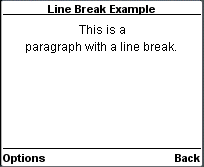
Text Paragraphs:
The <p> element defines a paragraph of text and WAP browsers always render a paragraph in a new line.
A <p> element is required to define any text, image or a table in WML.
The <p> element supports the following attributes:
| Attribute | Value | Description |
|---|---|---|
| align |
| This is used to change the horizontal alignment of a paragraph. |
| mode |
| Sets whether a paragraph should wrap lines or not. |
| xml:lang | language_code | Sets the language used in the element |
| class | class data | Sets a class name for the element. |
| id | element ID | A unique ID for the element. |
Following is the example showing usage of <p> element.
<?xml version="1.0"?> <!DOCTYPE wml PUBLIC "-//WAPFORUM//DTD WML 1.2//EN" "http://www.wapforum.org/DTD/wml12.dtd"> <wml> <card title="Paragraph Example"> <p align="center"> This is first paragraph </p> <p align="right"> This is second paragraph </p> </card> </wml>
This will produce the following result:
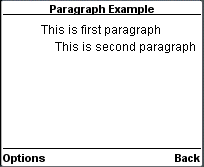
WML Tables:
The <table> element along with <tr> and <td> is used to create a table in WML. WML does not allow the nesting of tables
A <table> element should be put with-in <p>...</p> elements.
The <table /> element supports the following attributes:
| Attribute | Value | Description |
|---|---|---|
| columns | number | Sets the number of columns in the table |
| align |
| To specify the horizontal text alignment of the columns, you need to assign three letters to the align attribute. Each letter represents the horizontal text alignment of a column. The letter can be L, C, or R. For example, if you want the following settings to be applied to your table:
Then you should set the value of the align attribute to LCR. |
| xml:lang | language_code | Sets the language used in the element |
| class | class data | Sets a class name for the element. |
| id | element ID | A unique ID for the element. |
Following is the example showing usage of <table> element.
<?xml version="1.0"?> <!DOCTYPE wml PUBLIC "-//WAPFORUM//DTD WML 1.2//EN" "http://www.wapforum.org/DTD/wml12.dtd"> <wml> <card title="WML Tables"> <p> <table columns="3" align="LCR"> <tr> <td>Col 1</td> <td>Col 2</td> <td>Col 3</td> </tr> <tr> <td>A</td> <td>B</td> <td>C</td> </tr> <tr> <td>D</td> <td>E</td> <td>F</td> </tr> </table> </p> </card> </wml>
This will produce the following result:
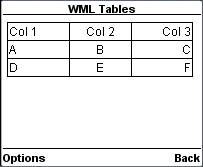
Preformatted Text:
The <pre> element is used to specify preformatted text in WML. Preformatted text is text of which the format follows the way it is typed in the WML document.
This tag preserves all the white spaces enclosed inside this tag. Make sure you are not putting this tag inside <p>...</p>
The <pre> element supports following attributes:
| Attribute | Value | Description |
|---|---|---|
| xml:lang | language_code | Sets the language used in the element |
| class | class data | Sets a class name for the element. |
| id | element ID | A unique ID for the element. |
Following is the example showing usage of <pre> element.
<?xml version="1.0"?>
<!DOCTYPE wml PUBLIC "-//WAPFORUM//DTD WML 1.2//EN"
"http://www.wapforum.org/DTD/wml12.dtd">
<wml>
<card title="Preformatted Text">
<pre>
This is preformatted
text and will appear
as it it.
</pre>
</card>
</wml>
This will produce the following result:
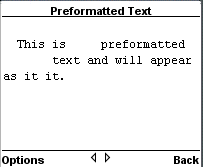
WML - Fonts
WML does not support <font> element, but there are other WML elements, which you can use to create different font effects like underlined text, bold text and italic text, etc.
These tags are given in the following table:
| WML Elements | Purpose |
|---|---|
| <b> | Defines bold text |
| <big> | Defines big text |
| <em> | Defines emphasized text |
| <i> | Defines italic text |
| <small> | Defines small text |
| <strong> | Defines strong text |
| <u> | Defines underlined text |
These elements support the following attributes:
| Attribute | Value | Description |
|---|---|---|
| xml:lang | language_code | Sets the language used in the element |
| class | class data | Sets a class name for the element. |
| id | element ID | A unique ID for the element. |
Following is the example showing usage of these elements.
<?xml version="1.0"?> <!DOCTYPE wml PUBLIC "-//WAPFORUM//DTD WML 1.2//EN" "http://www.wapforum.org/DTD/wml12.dtd"> <wml> <card title="Text Formatting"> <p> <b>bold text</b><br/> <big>big text</big><br/> <em>emphasized text</em><br/> <i>italic text</i><br/> <small>small text</small><br/> <strong>strong text</strong><br/> <u>underlined text</u> </p> </card> </wml>
This will produce the following result:
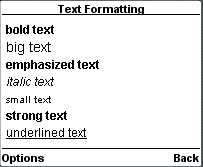
WML - Images
The <img> element is used to include an image in a WAP card. WAP-enabled wireless devices only supported the Wireless Bitmap (WBMP) image format.
WBMP images can only contain two colors: black and white. The file extension of WBMP is ".wbmp" and the MIME type of WBMP is "image/vnd.wap.wbmp".
The <img> element supports the following attributes:
| Attribute | Value | Description |
|---|---|---|
| align |
| Alignment of the image |
| alt | alternative text | Sets an alternate text to be displayed if the image is not displayed. |
| height |
| Height of the image in pixels or percentage. If you specify the value in pixels, the syntax is "140", instead of "140px". |
| hspace |
| Sets white space to the left and right of the image. If you specify the value in pixels, the syntax is "140", instead of "140px". |
| localsrc | cdata | Sets an alternate representation for the image. If this attribute is set, the browser will use it instead of the "src" attribute. |
| src | image url | A path to wbmp image. |
| vspace |
| Sets white space above and below the image. If you specify the value in pixels, the syntax is "140", instead of "140px". |
| width |
| Sets the width of the image.If you specify the value in pixels, the syntax is "140", instead of "140px". |
| xml:lang | language_code | Sets the language used in the element |
| class | class data | Sets a class name for the element. |
| id | element ID | A unique ID for the element. |
How to Make ".wbmp" Images
There are free tools available on the Internet to make ".wbmp" images.
The Nokia Mobile Internet Toolkit (NMIT) comes with a WBMP image editor that you can use. You can convert existing GIF or JPG image files into WBMP file using NMIT.
Another free tool is ImageMagick, which can help you to create WBMP images.
Following is the example showing usage of <img> element.
<?xml version="1.0"?> <!DOCTYPE wml PUBLIC "-//WAPFORUM//DTD WML 1.2//EN" "http://www.wapforum.org/DTD/wml12.dtd"> <wml> <card title="WML Images"> <p> This is Thumb image <img src="/images/thumb.wbmp" alt="Thumb Image"/> </p> <p> This is Heart image <img src="/images/heart.wbmp" alt="Heart Image"/> </p> </card> </wml>
This will produce the following result:
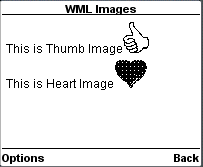
WML - Tables
The <table> element along with <tr> and <td> is used to create a table in WML. WML does not allow the nesting of tables
A <table> element should be put with-in <p>...</p> elements.
The <table /> element supports the following attributes:
| Attribute | Value | Description |
|---|---|---|
| columns | number | Sets the number of columns in the table |
| align |
| To specify the horizontal text alignment of the columns, you need to assign three letters to the align attribute. Each letter represents the horizontal text alignment of a column. The letter can be L, C, or R. For example, if you want the following settings to be applied to your table:
Then you should set the value of the align attribute to LCR. |
| xml:lang | language_code | Sets the language used in the element |
| class | class data | Sets a class name for the element. |
| id | element ID | A unique ID for the element. |
Following is the example showing usage of <table> element.
<?xml version="1.0"?> <!DOCTYPE wml PUBLIC "-//WAPFORUM//DTD WML 1.2//EN" "http://www.wapforum.org/DTD/wml12.dtd"> <wml> <card title="WML Tables"> <p> <table columns="3" align="LCR"> <tr> <td>Col 1</td> <td>Col 2</td> <td>Col 3</td> </tr> <tr> <td>A</td> <td>B</td> <td>C</td> </tr> <tr> <td>D</td> <td>E</td> <td>F</td> </tr> </table> </p> </card> </wml>
This will produce the following result:

WML - Links
WML provides you an option to link various cards using links and then navigate through different cards.
There are two WML elements, <anchor> and <a>, which can be used to create WML links.
WML <anchor> Element:
The <anchor>...</anchor> tag pair is used to create an anchor link. It is used together with other WML elements called <go/>, <refresh> or <prev/>. These elements are called task elements and tell WAP browsers what to do when a user selects the anchor link
You can enclose Text or image along with a task tag inside <anchor>...</anchor> tag pair.
The <anchor> element supports the following attributes:
| Attribute | Value | Description |
|---|---|---|
| title | cdata | Defines a text identifying the link |
| xml:lang | language_code | Sets the language used in the element |
| class | class data | Sets a class name for the element. |
| id | element ID | A unique ID for the element. |
Following is the example showing usage of <anchor> element.
<?xml version="1.0"?>
<!DOCTYPE wml PUBLIC "-//WAPFORUM//DTD WML 1.2//EN"
"http://www.wapforum.org/DTD/wml12.dtd">
<wml>
<card title="Anchor Element">
<p>
<anchor>
<go href="nextpage.wml"/>
</anchor>
</p>
<p>
<anchor>
<prev/>
</anchor>
</p>
</card>
</wml>
This will produce the following result:
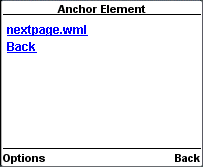
WML <a> Element:
The <a>...</a> tag pair can also be used to create an anchor link and always a preferred way of creating links.
You can enclose Text or image inside <a>...</a> tags.
The <a> element supports the following attributes:
| Attribute | Value | Description |
|---|---|---|
| href | URL | Defines URL of the liked page |
| title | cdata | Defines a text identifying the link |
| xml:lang | language_code | Sets the language used in the element |
| class | class data | Sets a class name for the element. |
| id | element ID | A unique ID for the element. |
Following is the example showing usage of <a> element.
<?xml version="1.0"?> <!DOCTYPE wml PUBLIC "-//WAPFORUM//DTD WML 1.2//EN" "http://www.wapforum.org/DTD/wml12.dtd"> <wml> <card title="A Element"> <p> Link to Next Page: <a href="nextpage.wml">Next Page</a> </p> </card> </wml>
This will produce the following result:
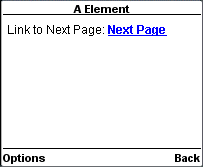
WML - Tasks
A WML task is an element that specifies an action to be performed by the browser, rather than something to be displayed. For example, the action of changing to a new card is represented by a <go> task element, and the action of returning to the previous card visited is represented by a <prev> task element. Task elements encapsulate all the information required to perform the action.
WML provides following four elements to handle four WML tasks called go task, pre task, refresh task and noop taks.
The <go> Task:
As the name suggests, the <go> task represents the action of going to a new card.
The <go> element supports the following attributes:
| Attribute | Value | Description |
|---|---|---|
| href | URL | Gives the URL of the new card. Relative URLs are resolved relative to the current card |
| method |
| Specifies the method that should be used to fetch the deck. This must be one of the values get or post,
corresponding to the GET and POST methods of HTTP. When using method="get", the data is sent as an request with ? data appended to the url. The method has a disadvantage, that it can be used only for a limited amount of data, and if you send sensitive information it will be displayed on the screen and saved in the web server's logs. So do not use this method if you are sending password etc. With method="post", the data is sent as an request with the data sent in the body of the request. This method has no limit, and sensitive information is not visible in the URL |
| sendreferer |
| If set to true, the browser sends the URL of the current deck along with the request. This URL is sent as a relative URL if possible. The purpose of this is to allow servers to perform simple access control on decks, based on which decks are linking to them. For example, using HTTP, this attribute is sent in the HTTP Referer header. |
| accept-charset | charset_list | Specifies a comma- or space-separated list of character sets that can encode data sent to the server in a POST request. The default value is "unknown". |
| class | class data | Sets a class name for the element. |
| id | element ID | A unique ID for the element. |
Following is the example showing usage of <go> element.
<?xml version="1.0"?>
<!DOCTYPE wml PUBLIC "-//WAPFORUM//DTD WML 1.2//EN"
"http://www.wapforum.org/DTD/wml12.dtd">
<wml>
<card title="GO Element">
<p>
<anchor>
Chapter 2 : <go href="chapter2.wml"/>
</anchor>
</p>
</card>
</wml>
Another example showing how to upload data using Get Method
<?xml version="1.0"?>
<!DOCTYPE wml PUBLIC "-//WAPFORUM//DTD WML 1.2//EN"
"http://www.wapforum.org/DTD/wml12.dtd">
<wml>
<card title="GO Element">
<p>
<anchor>
Using Get Method
<go href="chapter2.wml?x=17&y=42" method="get"/>
</anchor>
</p>
</card>
</wml>
Another example showing how to upload data using <setvar> element.
<?xml version="1.0"?>
<!DOCTYPE wml PUBLIC "-//WAPFORUM//DTD WML 1.2//EN"
"http://www.wapforum.org/DTD/wml12.dtd">
<wml>
<card title="GO Element">
<p>
<anchor>
Using setvar:
<go href="chapter2.wml">
<setvar name="x" value="17"/>
<setvar name="y" value="42"/>
</go>
</anchor>
</p>
</card>
</wml>
Another example showing how to upload data using <postfiled> element
<?xml version="1.0"?>
<!DOCTYPE wml PUBLIC "-//WAPFORUM//DTD WML 1.2//EN"
"http://www.wapforum.org/DTD/wml12.dtd">
<wml>
<card title="GO Element">
<p>
<anchor>
Using setvar:
<go href="chapter2.wml" method="get">
<postfield name="x" value="17"/>
<postfield name="y" value="42"/>
</go>
</anchor>
</p>
</card>
</wml>
The <prev> Task:
The <prev> task represents the action of returning to the previously visited card on the history stack. When this action is performed, the top entry is removed from the history stack, and that card is displayed again, after any <setvar> variable assignments in the <prev> task have taken effect.
If no previous URL exists, specifying <prev> has no effect.
The <prev> element supports the following attributes:
| Attribute | Value | Description |
|---|---|---|
| class | class data | Sets a class name for the element. |
| id | element ID | A unique ID for the element. |
Following is the example showing usage of <prev> element.
<?xml version="1.0"?>
<!DOCTYPE wml PUBLIC "-//WAPFORUM//DTD WML 1.2//EN"
"http://www.wapforum.org/DTD/wml12.dtd">
<wml>
<card title="Prev Element">
<p>
<anchor>
Previous Page :<prev/>
</anchor>
</p>
</card>
</wml>
One situation where it can be useful to include variables in a <prev> task is a login page, which prompts for a username and password. In some situations, you may want to clear out the password field when returning to the login card, forcing the user to reenter it. This can be done with a construct such as:
<?xml version="1.0"?>
<!DOCTYPE wml PUBLIC "-//WAPFORUM//DTD WML 1.2//EN"
"http://www.wapforum.org/DTD/wml12.dtd">
<wml>
<card title="Prev Element">
<p>
<anchor>
<prev>
<setvar name="password" value=""/>
</prev>
</anchor>
</p>
</card>
</wml>
The <refresh> Task:
The <refresh> task is the simplest task that actually does something. Its effect is simply to perform the variable assignments specified by its <setvar> elements, then redisplay the current card with the new values. The <go> and <prev> tasks perform the same action just before displaying the new card.
The <refresh> task is most often used to perform some sort of "reset" action on the card.
The <refresh> element supports the following attributes:
| Attribute | Value | Description |
|---|---|---|
| class | class data | Sets a class name for the element. |
| id | element ID | A unique ID for the element. |
Following is the example showing usage of <refresh> element.
<?xml version="1.0"?>
<!DOCTYPE wml PUBLIC "-//WAPFORUM//DTD WML 1.2//EN"
"http://www.wapforum.org/DTD/wml12.dtd">
<wml>
<card title="Referesh Element">
<p>
<anchor>
Refresh this page:
<go href="test.wml"/>
<refresh>
<setvar name="x" value="100"/>
</refresh>
</anchor>
</p>
</card>
</wml>
The <noop> Task:
The purpose of the <noop> task is to do nothing (no operation).
The only real use for this task is in connection with templates
The <noop> element supports the following attributes:
| Attribute | Value | Description |
|---|---|---|
| class | class data | Sets a class name for the element. |
| id | element ID | A unique ID for the element. |
Following is the example showing usage of <noop> element.
<?xml version="1.0"?>
<!DOCTYPE wml PUBLIC "-//WAPFORUM//DTD WML 1.2//EN"
"http://www.wapforum.org/DTD/wml12.dtd">
<wml>
<card title="Noop Element">
<p>
<do type="prev" label="Back">
<noop/>
</do>
</p>
</card>
</wml>
WML - Inputs
WML provides various options to let a user enter information through WAP application.
First of all, we are going to look at the different options for allowing the user to make straight choices between items. These are usually in the form of menus and submenus, allowing users to drill down to the exact data that they want.
WML <select> Element:
The <select>...</select> WML elements are used to define a selection list and the <option>...</option> tags are used to define an item in a selection list. Items are presented as radiobuttons in some WAP browsers. The <option>...</option> tag pair should be enclosed within the <select>...</select> tags.
This element support the following attributes:
| Attribute | Value | Description |
|---|---|---|
| iname | text | Names the variable that is set with the index result of the selection |
| ivalue | text | Sets the pre-selected option element |
| multiple |
| Sets whether multiple items can be selected. Default is "false" |
| name | text | Names the variable that is set with the result of the selection |
| tabindex | number | Sets the tabbing position for the select element |
| title | text | Sets a title for the list |
| value | text | Sets the default value of the variable in the "name" attribute |
| xml:lang | language_code | Sets the language used in the element |
| class | class data | Sets a class name for the element. |
| id | element ID | A unique ID for the element. |
Following is the example showing usage of these two elements.
<?xml version="1.0"?> <!DOCTYPE wml PUBLIC "-//WAPFORUM//DTD WML 1.2//EN" "http://www.wapforum.org/DTD/wml12.dtd"> <wml> <card title="Selectable List"> <p> Select a Tutorial : <select> <option value="htm">HTML Tutorial</option> <option value="xml">XML Tutorial</option> <option value="wap">WAP Tutorial</option> </select> </p> </card> </wml>
When you will load this program, it will show you the following screen:
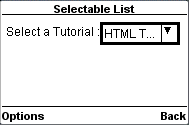
Once you highlight and enter on the options, it will display the following screen:
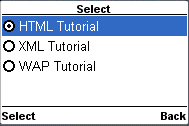
You want to provide option to select multiple options, then set multiple attribute to true as follows:
<?xml version="1.0"?> <!DOCTYPE wml PUBLIC "-//WAPFORUM//DTD WML 1.2//EN" "http://www.wapforum.org/DTD/wml12.dtd"> <wml> <card title="Selectable List"> <p> Select a Tutorial : <select multiple="true"> <option value="htm">HTML Tutorial</option> <option value="xml">XML Tutorial</option> <option value="wap">WAP Tutorial</option> </select> </p> </card> </wml>
This will give you a screen to select multiple options as follows:
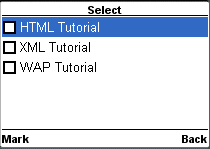
WML <input> Element:
The <input/> element is used to create input fields and input fields are used to obtain alphanumeric data from users.
This element support the following attributes:
| Attribute | Value | Description |
|---|---|---|
| name | text | The name of the variable that is set with the result of the user's input |
| maxlength | number | Sets the maximum number of characters the user can enter in the field |
| emptyok |
| Sets whether the user can leave the input field blank or not. Default is "false" |
| format | A a N X x M m *f nf |
Sets the data format for the input field. Default is "*M".
A = uppercase alphabetic or punctuation characters |
| size | number | Sets the width of the input field |
| tabindex | number | Sets the tabbing position for the select element |
| title | text | Sets a title for the list |
| type |
| Indicates the type of the input field. The default value is "text". Password field is used to take password for authentication purpose. |
| value | text | Sets the default value of the variable in the "name" attribute |
| xml:lang | language_code | Sets the language used in the element |
| class | class data | Sets a class name for the element. |
| id | element ID | A unique ID for the element. |
Following is the example showing usage of this element.
<?xml version="1.0"?> <!DOCTYPE wml PUBLIC "-//WAPFORUM//DTD WML 1.2//EN" "http://www.wapforum.org/DTD/wml12.dtd"> <wml> <card title="Input Fields"> <p> Enter Following Information:<br/> Name: <input name="name" size="12"/> Age : <input name="age" size="12" format="*N"/> Sex : <input name="sex" size="12"/> </p> </card> </wml>
This will provide you the following screen to enter required information:
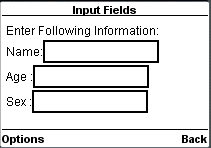
WML <fieldset> Element:
The <fieldset/> element is used to group various input fields or selectable lists.
This element support the following attributes:
| Attribute | Value | Description |
|---|---|---|
| title | text | Sets a title for the list |
| xml:lang | language_code | Sets the language used in the element |
| class | class data | Sets a class name for the element. |
| id | element ID | A unique ID for the element. |
Following is the example showing usage of this element.
<?xml version="1.0"?> <!DOCTYPE wml PUBLIC "-//WAPFORUM//DTD WML 1.2//EN" "http://www.wapforum.org/DTD/wml12.dtd"> <wml> <card title="Grouped Fields"> <p> <fieldset title="Personal Info"> Name: <input name="name" size="12"/> Age : <input name="age" size="12" format="*N"/> Sex : <input name="sex" size="12"/> </fieldset> </p> </card> </wml>
This will provide you the following screen to enter required information. This result may differ browser to browser.
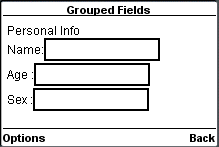
WML <optgroup> Element
The <optgroup/> element is used to group various options together inside a selectable list.
This element support the following attributes:
| Attribute | Value | Description |
|---|---|---|
| title | text | Sets a title for the list |
| xml:lang | language_code | Sets the language used in the element |
| class | class data | Sets a class name for the element. |
| id | element ID | A unique ID for the element. |
Following is the example showing usage of this element.
<?xml version="1.0"?>
<!DOCTYPE wml PUBLIC "-//WAPFORUM//DTD WML 1.2//EN"
"http://www.wapforum.org/DTD/wml12.dtd">
<wml>
<card title="Selectable List">
<p>
<select>
<optgroup title="India">
<option value="delhi">Delhi</option>
<option value="mumbai">Mumbai</option>
<option value="hyderabad">Hyderabad</option>
</optgroup>
<optgroup title="USA">
<option value="ohio">Ohio</option>
<option value="maryland">Maryland</option>
<option value="washington">Washingtone</option>
</optgroup>
</select>
</p>
</card>
</wml>
When a user loads above code, then it will give two options to be selected:
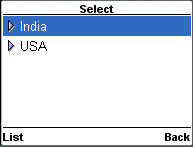
When a user selects any of the options, then only it will give final options to be selected. So if user selects India, then it will show you following options to be selected:
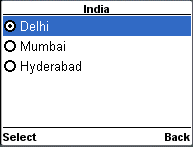
WML - Submit Data
Many times, you will want your users to submit some data to your server. Similar to HTML Form WML also provide a mechanism to submit user data to web server.
To submit data to the server in WML, you need the <go>...</go> along with <postfield/> tags. The <postfield/> tag should be enclosed in the <go>...</go> tag pair.
To submit data to a server, we collect all the set WML variables and use <postfield> elements to send them to the server. The <go>...</go> elements are used to set posting method to either POST or GET and to specify a server side script to handle uploaded data.
In previous chapters we have explained various ways of taking inputs form the users. These input elements sets WML variables to the entered values. We also know how to take values from WML variables. So now following example shows how to submit three fields name, age and sex to the server.
<?xml version="1.0"?>
<!DOCTYPE wml PUBLIC "-//WAPFORUM//DTD WML 1.2//EN"
"http://www.wapforum.org/DTD/wml12.dtd">
<wml>
<card id="card1" title="WML Form">
<p>
Name: <input name="name" size="12"/>
Sex : <select name="sex">
<option value="male">Male</option>
<option value="female">Female</option>
</select>
Age : <input name="age" size="12" format="*N"/>
<anchor>
<go method="get" href="process.php">
<postfield name="name" value="$(name)"/>
<postfield name="age" value="$(age)"/>
<postfield name="sex" value="$(sex)"/>
</go>
Submit Data
</anchor>
</p>
</card>
</wml>
When you download above code on your WAP device, it will provide you option to enter three fields name, age and sex and one link Submit Data. You will enter three fields and then finally you will select Submit Data link to send entered data to the server.
The method attribute of the <go> tag specifies which HTTP method should be used to send the form data.
If the HTTP POST method is used, the form data to be sent will be placed in the message body of the request. If the HTTP GET method is used, the form data to be sent will be appended to the URL. Since a URL can only contain a limited number of characters, the GET method has the disadvantage that there is a size limit for the data to be sent. If the user data contains non-ASCII characters, you should make use of the POST method to avoid encoding problems.
There is one major difference between HTML and WML. In HTML, the name attribute of the <input> and <select> tags is used to specify the name of the parameter to be sent, while in WML the name attribute of the <postfield> tag is used to do the same thing. In WML, the name attribute of <input> and <select> is used to specify the name of the variable for storing the form data.
Next chapter will teach you how to handle uploaded data at server end.
WML - Server Scripts
If you already know how to write server side scripts for Web Application, then for you this is very simple to write Server Side program for WML applications. You can use your favorite server-side technology to do the processing required by your mobile Internet application.
At the server side, the parameter name will be used to retrieve the form data.
Consider the following example from previous chapter to submit name, age and sex of a person:
<?xml version="1.0"?>
<!DOCTYPE wml PUBLIC "-//WAPFORUM//DTD WML 1.2//EN"
"http://www.wapforum.org/DTD/wml12.dtd">
<wml>
<card id="card1" title="WML Form">
<p>
Name: <input name="name" size="12"/>
Sex : <select name="sex">
<option value="male">Male</option>
<option value="female">Female</option>
</select>
Age : <input name="age" size="12" format="*N"/>
<anchor>
<go method="get" href="process.php">
<postfield name="name" value="$(name)"/>
<postfield name="age" value="$(age)"/>
<postfield name="sex" value="$(sex)"/>
</go>
Submit Data
</anchor>
</p>
</card>
</wml>
WML and PHP
Now, we can write a server side script to handle this submitted data in using either PHP, PERL, ASP or JSP. I will show you a server side script written in PHP with HTTP GET method.
Put the following PHP code in process.php file in same directory where you have your WML file.
<?php echo 'Content-type: text/vnd.wap.wml'; ?>
<?php echo '<?xml version="1.0"?'.'>'; ?>
<!DOCTYPE wml PUBLIC "-//WAPFORUM//DTD WML 1.2//EN"
"http://www.wapforum.org/DTD/wml12.dtd">
<wml>
<card id="card1" title="WML Response">
<p>
Data received at the server:<br/>
Name: <?php echo $_GET["name"]; ?><br/>
Age: <?php echo $_GET["age"]; ?><br/>
Sex: <?php echo $_GET["sex"]; ?><br/>
</p>
</card>
</wml>
If you are using HTTP POST method, then you have to write PHP script accordingly to handle received data. While sending output back to the browser, remember to set the MIME type of the document to "text/vnd.wap.wml".
This way, you can write full fledged Web Application where lot of database transactions are involved.
You can use PERL CGI Concepts to write a dynamic WAP site.
WML - Events
Event in ordinary language can be defined as something happened. In programming, event is identical in meaning, but with one major difference. When something happens in a computer system, the system itself has to (1) detect that something has happened and (2) know what to do about it.
WML language also supports events and you can specify an action to be taken whenever an event occurs. This action could be in terms of WMLScript or simply in terms of WML.
WML supports following four event types:
onenterbackward: This event occurs when the user hits a card by normal backward navigational means. That is, user presses the Back key on a later card and arrives back at this card in the history stack.
onenterforward: This event occurs when the user hits a card by normal forward navigational means.
onpick: This is more like an attribute but it is being used like an event. This event occurs when an item of a selection list is selected or deselected.
ontimer: This event is used to trigger an event after a given time period.
These event names are case sensitive and they must be lowercase.
WML <onevent> Element:
The <onevent>...</onevent> tags are used to create event handlers. Its usage takes the following form:
<onevent type="event_type"> A task to be performed. </onevent>
You can use either go, prev or refresh task inside <onevent>...</onevent> tags against an event.
The <onevent> element supports the following attributes:
| Attribute | Value | Description |
|---|---|---|
| type |
| Defines a type of event occured. |
| class | class data | Sets a class name for the element. |
| id | element ID | A unique ID for the element. |
Following is the example showing usage of <onevent> element. In this example, whenever you try to go back from second card to first card then onenterbackward occurs which moves you to card number three. Copy and paste this program and try to play with it.
<?xml version="1.0"?>
<!DOCTYPE wml PUBLIC "-//WAPFORUM//DTD WML 1.2//EN"
"http://www.wapforum.org/DTD/wml12.dtd">
<wml>
<onevent type="onenterbackward">
<go href="#card3"/>
</onevent>
<card id="card1" title="Card 1">
<p>
<anchor>
<go href="#card2"/>
Go to card 2
</anchor>
</p>
</card>
<card id="card2" title="Card 2">
<p>
<anchor>
<prev/>
Going backwards
</anchor>
</p>
</card>
<card id="card3" title="Card 3">
<p>
Hello World!
</p>
</card>
</wml>
WML - Timer
Previous chapter has described how events are triggered by the users and how do we handle them using event handlers.
Sometime, you may want something to happen without the user explicitly having to activate a control. Yes, WML provides you ontimer event to handle this.
The ontimer event is triggered when a card's timer counts down from one to zero, which means that it doesn't occur if the timer is initialized to a timeout of zero.
You can bind a task to this event with the <onevent> element. Here is the syntax:
<onevent type="ontimer"> A task to be performed. </onevent>
Here, a task could be <go>, <prev> or <refresh>.
WML <timer> Element:
A timer is declared inside a WML card with the <timer> element. It must follow the <onevent> elements if they are present. (If there are no <onevent> elements, the <timer> must be the first element inside the <card>.) No more than one <timer> may be present in a card.
The <timer> element supports the following attributes:
| Attribute | Value | Description |
|---|---|---|
| name | text | Sets a name for the element. |
| value | number | Specifies the timer after which timer will be expired. Timeouts are specified in units of a tenth of a second. |
| class | class_data | Sets a class name for the element. |
| id | element ID | A unique ID for the element. |
Following is the example showing usage of <timer> element.
<?xml version="1.0"?>
<!DOCTYPE wml PUBLIC "-//WAPFORUM//DTD WML 1.2//EN"
"http://www.wapforum.org/DTD/wml12.dtd">
<wml>
<card id="splash" title="splash">
<onevent type="ontimer">
<go href="#welcome"/>
</onevent>
<timer value="50"/>
<p>
<a href="#welcome">Enter</a>
</p>
</card>
<card id="welcome" title="Welcome">
<p>
Welcome to the main screen.
</p>
</card>
</wml>
When you load this program it shows you following screen:
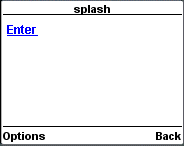
If you do not select given Enter option then after 5 seconds, you will be directed to Welcome page and following screen will be displayed automatically.
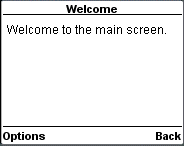
WML - Template
The <template> is used to apply <do> and <onevent> elements to all cards in a deck. This element defines a template for all the cards in a deck and the code in the <template> tag is added to each card in the deck.
You can override a <do> element of a template by defining another <do> element with the same name attribute value in a WML card.
The <template> element supports the following attributes:
| Attribute | Value | Description |
|---|---|---|
| onenterbackward | URL | Occurs when the user navigates into a card using a "prev" task |
| onenterforward | URL | Occurs when the user navigates into a card using a "go" task |
| ontimer | URL | Occurs when the "timer" expires |
| class | class data | Sets a class name for the element. |
| id | element ID | A unique ID for the element. |
Following is the example showing usage of <go> element.
<?xml version="1.0"?>
<!DOCTYPE wml PUBLIC "-//WAPFORUM//DTD WML 1.3//EN"
"http://www.wapforum.org/DTD/wml13.dtd">
<wml>
<template>
<do name="main_menu" type="accept" label="Chapters">
<go href="chapters"/>
</do>
<do name="menu_1" type="accept" label="Chapter 1">
<go href="#chapter1"/>
</do>
<do name="menu_2" type="accept" label="Chapter 2">
<go href="#chapter2"/>
</do>
<do name="menu_3" type="accept" label="Chapter 3">
<go href="#chapter3"/>
</do>
<do name="menu_4" type="accept" label="Chapter 4">
<go href="#chapter4"/>
</do>
</template>
<card id="chapters" title="WML Tutorial">
<p>
Select One Chapter:<br/>
<anchor>
<go href="#chapter1"/>
Chapter 1: WML Overview
</anchor><br />
<anchor>
<go href="#chapter2"/>
Chapter 2: WML Environment
</anchor><br />
<anchor>
<go href="#chapter3"/>
Chapter 3: WML Syntax
</anchor><br />
<anchor>
<go href="#chapter4"/>
Chapter 4: WML Elements
</anchor><br />
</p>
</card>
<card id="chapter1" title="WML Tutorial Ch1">
<p>
<em>Chapter 1: WML Introduction</em><br/>
...
</p>
</card>
<card id="chapter2" title="WML Tutorial Ch2">
<p>
<em>Chapter 2: WML Environment</em><br/>
...
</p>
</card>
<card id="chapter3" title="WML Tutorial Ch3">
<p>
<em>Chapter 3: WML Syntax</em><br/>
...
</p>
</card>
<card id="chapter4" title="WML Tutorial Ch4">
<p>
<em>Chapter 4: WML Elements</em><br/>
...
</p>
</card>
</wml>
This will produce the following menu and now you can navigate through all the chapters:
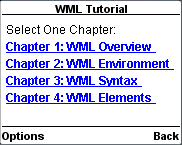
WML - DTD
Here is the complete DTD taken from W3.org. For a latest DTD, please check WML Useful Resources section of this tutorial.
<!--
Wireless Markup Language (WML) Document Type Definition.
WML is an XML language. Typical usage:
<?xml version="1.0"?>
<!DOCTYPE wml PUBLIC "-//WAPFORUM//DTD WML 1.2//EN"
"http://www.wapforum.org/DTD/wml12.dtd">
<wml>
...
</wml>
Terms and conditions of use are available from the WAP Forum
Ltd. web site at http://www.wapforum.org/docs/copyright.htm.
-->
<!ENTITY % length "CDATA">
<!-- [0-9]+ for pixels or [0-9]+"%" for
percentage length -->
<!ENTITY % vdata "CDATA">
<!-- attribute value possibly containing
variable references -->
<!ENTITY % HREF "%vdata;">
<!-- URI, URL or URN designating a hypertext
node. May contain variable references -->
<!ENTITY % boolean "(true|false)">
<!ENTITY % number "NMTOKEN">
<!-- a number, with format [0-9]+ -->
<!ENTITY % coreattrs "id ID #IMPLIED
class CDATA #IMPLIED">
<!ENTITY % ContentType "%vdata;">
<!-- media type. May contain variable references -->
<!ENTITY % emph "em | strong |b |i |u |big |small">
<!ENTITY % layout "br">
<!ENTITY % text "#PCDATA | %emph;">
<!-- flow covers "card-level" elements,
such as text and images -->
<!ENTITY % flow "%text; | %layout; | img | anchor |a |table">
<!-- Task types -->
<!ENTITY % task "go | prev | noop | refresh">
<!-- Navigation and event elements -->
<!ENTITY % navelmts "do | onevent">
<!--================ Decks and Cards ================-->
<!ELEMENT wml ( head?, template?, card+ )>
<!ATTLIST wml
xml:lang NMTOKEN #IMPLIED
%coreattrs;
>
<!-- card intrinsic events -->
<!ENTITY % cardev
"onenterforward %HREF; #IMPLIED
onenterbackward %HREF; #IMPLIED
ontimer %HREF; #IMPLIED"
>
<!-- card field types -->
<!ENTITY % fields "%flow; | input | select | fieldset">
<!ELEMENT card (onevent*, timer?, (do | p | pre)*)>
<!ATTLIST card
title %vdata; #IMPLIED
newcontext %boolean; "false"
ordered %boolean; "true"
xml:lang NMTOKEN #IMPLIED
%cardev;
%coreattrs;
>
<!--================ Event Bindings ================-->
<!ELEMENT do (%task;)>
<!ATTLIST do
type CDATA #REQUIRED
label %vdata; #IMPLIED
name NMTOKEN #IMPLIED
optional %boolean; "false"
xml:lang NMTOKEN #IMPLIED
%coreattrs;
>
<!ELEMENT onevent (%task;)>
<!ATTLIST onevent
type CDATA #REQUIRED
%coreattrs;
>
<!--================ Deck-level declarations ================-->
<!ELEMENT head ( access | meta )+>
<!ATTLIST head
%coreattrs;
>
<!ELEMENT template (%navelmts;)*>
<!ATTLIST template
%cardev;
%coreattrs;
>
<!ELEMENT access EMPTY>
<!ATTLIST access
domain CDATA #IMPLIED
path CDATA #IMPLIED
%coreattrs;
>
<!ELEMENT meta EMPTY>
<!ATTLIST meta
http-equiv CDATA #IMPLIED
name CDATA #IMPLIED
forua %boolean; "false"
content CDATA #REQUIRED
scheme CDATA #IMPLIED
%coreattrs;
>
<!--================ Tasks ================-->
<!ELEMENT go (postfield | setvar)*>
<!ATTLIST go
href %HREF; #REQUIRED
sendreferer %boolean; "false"
method (post|get) "get"
enctype %ContentType; "application/x-www-form-urlencoded"
accept-charset CDATA #IMPLIED
%coreattrs;
>
<!ELEMENT prev (setvar)*>
<!ATTLIST prev
%coreattrs;
>
<!ELEMENT refresh (setvar)*>
<!ATTLIST refresh
%coreattrs;
>
<!ELEMENT noop EMPTY>
<!ATTLIST noop
%coreattrs;
>
<!--================ postfield ================-->
<!ELEMENT postfield EMPTY>
<!ATTLIST postfield
name %vdata; #REQUIRED
value %vdata; #REQUIRED
%coreattrs;
>
<!--================ variables ================-->
<!ELEMENT setvar EMPTY>
<!ATTLIST setvar
name %vdata; #REQUIRED
value %vdata; #REQUIRED
%coreattrs;
>
<!--================ Card Fields ================-->
<!ELEMENT select (optgroup|option)+>
<!ATTLIST select
title %vdata; #IMPLIED
name NMTOKEN #IMPLIED
value %vdata; #IMPLIED
iname NMTOKEN #IMPLIED
ivalue %vdata; #IMPLIED
multiple %boolean; "false"
tabindex %number; #IMPLIED
xml:lang NMTOKEN #IMPLIED
%coreattrs;
>
<!ELEMENT optgroup (optgroup|option)+ >
<!ATTLIST optgroup
title %vdata; #IMPLIED
xml:lang NMTOKEN #IMPLIED
%coreattrs;
>
<!ELEMENT option (#PCDATA | onevent)*>
<!ATTLIST option
value %vdata; #IMPLIED
title %vdata; #IMPLIED
onpick %HREF; #IMPLIED
xml:lang NMTOKEN #IMPLIED
%coreattrs;
>
<!ELEMENT input EMPTY>
<!ATTLIST input
name NMTOKEN #REQUIRED
type (text|password) "text"
value %vdata; #IMPLIED
format CDATA #IMPLIED
emptyok %boolean; "false"
size %number; #IMPLIED
maxlength %number; #IMPLIED
tabindex %number; #IMPLIED
title %vdata; #IMPLIED
accesskey %vdata; #IMPLIED
xml:lang NMTOKEN #IMPLIED
%coreattrs;
>
<!ELEMENT fieldset (%fields; | do)* >
<!ATTLIST fieldset
title %vdata; #IMPLIED
xml:lang NMTOKEN #IMPLIED
%coreattrs;
>
<!ELEMENT timer EMPTY>
<!ATTLIST timer
name NMTOKEN #IMPLIED
value %vdata; #REQUIRED
%coreattrs;
>
<!--================ Images ================-->
<!ENTITY % IAlign "(top|middle|bottom)" >
<!ELEMENT img EMPTY>
<!ATTLIST img
alt %vdata; #REQUIRED
src %HREF; #REQUIRED
localsrc %vdata; #IMPLIED
vspace %length; "0"
hspace %length; "0"
align %IAlign; "bottom"
height %length; #IMPLIED
width %length; #IMPLIED
xml:lang NMTOKEN #IMPLIED
%coreattrs;
>
<!--================ Anchor ================-->
<!ELEMENT anchor ( #PCDATA | br | img | go | prev | refresh )*>
<!ATTLIST anchor
title %vdata; #IMPLIED
accesskey %vdata; #IMPLIED
xml:lang NMTOKEN #IMPLIED
%coreattrs;
>
<!ELEMENT a ( #PCDATA | br | img )*>
<!ATTLIST a
href %HREF; #REQUIRED
title %vdata; #IMPLIED
accesskey %vdata; #IMPLIED
xml:lang NMTOKEN #IMPLIED
%coreattrs;
>
<!--================ Tables ================-->
<!ELEMENT table (tr)+>
<!ATTLIST table
title %vdata; #IMPLIED
align CDATA #IMPLIED
columns %number; #REQUIRED
xml:lang NMTOKEN #IMPLIED
%coreattrs;
>
<!ELEMENT tr (td)+>
<!ATTLIST tr
%coreattrs;
>
<!ELEMENT td ( %text; | %layout; | img | anchor |a )*>
<!ATTLIST td
xml:lang NMTOKEN #IMPLIED
%coreattrs;
>
<!--============ Text layout and line breaks =============-->
<!ELEMENT em (%flow;)*>
<!ATTLIST em
xml:lang NMTOKEN #IMPLIED
%coreattrs;
>
<!ELEMENT strong (%flow;)*>
<!ATTLIST strong
xml:lang NMTOKEN #IMPLIED
%coreattrs;
>
<!ELEMENT b (%flow;)*>
<!ATTLIST b
xml:lang NMTOKEN #IMPLIED
%coreattrs;
>
<!ELEMENT i (%flow;)*>
<!ATTLIST i
xml:lang NMTOKEN #IMPLIED
%coreattrs;
>
<!ELEMENT u (%flow;)*>
<!ATTLIST u
xml:lang NMTOKEN #IMPLIED
%coreattrs;
>
<!ELEMENT big (%flow;)*>
<!ATTLIST big
xml:lang NMTOKEN #IMPLIED
%coreattrs;
>
<!ELEMENT small (%flow;)*>
<!ATTLIST small
xml:lang NMTOKEN #IMPLIED
%coreattrs;
>
<!ENTITY % TAlign "(left|right|center)">
<!ENTITY % WrapMode "(wrap|nowrap)" >
<!ELEMENT p (%fields; | do)*>
<!ATTLIST p
align %TAlign; "left"
mode %WrapMode; #IMPLIED
xml:lang NMTOKEN #IMPLIED
%coreattrs;
>
<!ELEMENT br EMPTY>
<!ATTLIST br
%coreattrs;
>
<!ELEMENT pre (#PCDATA | a | br | i | b | em | strong |
input | select )*>
<!ATTLIST pre
xml:space CDATA #FIXED "preserve"
%coreattrs;
>
<!ENTITY quot """> <!-- quotation mark -->
<!ENTITY amp "&"> <!-- ampersand -->
<!ENTITY apos "'"> <!-- apostrophe -->
<!ENTITY lt "<"> <!-- less than -->
<!ENTITY gt ">"> <!-- greater than -->
<!ENTITY nbsp " "> <!-- non-breaking space -->
<!ENTITY shy ""> <!-- soft hyphen (discretionary hyphen) -->
WML2 - Tutorial
WML2 is a language, which extends the syntax and semantics of the followings:
- XHTML Basic [ XHTMLBasic ]
- CSS Mobile Profile [ CSSMP ]
- Unique semantics of WML1.0 [ WML1.0 ]
WML2 is optimised for specifying presentation and user interaction on limited capability devices such as mobile phones and other wireless mobile terminals.
This tutorial gives detail of the Wireless Markup Language (WML) Version 2. This tutorial refers to version 2.0 of WML as WML2.
The XHTML Basic defined by the W3C is a proper subset of XHTML, which is a reformulation of HTML in XML.
Basic Goals of WML2:
There are five major goals for WML2:
Backward compatibility: WML2 application should be running on old devices as well.
Convergence with existing and evolving Internet standards: XHTML Basic [XHTMLBasic] and CSS Mobile Profile [CSSMP]
Optimisation of access from small, limited devices: WAP-enabled devices are generally small and battery operated and they have relatively limited memory and CPU power. So WML2 should be optimized enough to run on these devices.
Allowance for the creation of distinct user interfaces: WAP enables the creation of Man Machine Interfaces (MMIs) with maximum flexibility and ability for a vendor to enhance the user experience.
Internationalisation of the architecture: WAP targets common character codes for international use. This includes international symbols and pictogram sets for end users, and local-use character encoding for content developers.
WML2 Vision:
The WML2 vision is to create a language that extends the syntax and semantics of XHTML Basic and CSS Mobile profile with the unique semantics of WML1. The user should not be aware of how WML1 compatibility is achieved.
The WML2 Language Structure:
WML2 is a new language with the following components:
(1) XHTML Basic:
This element group is for W3C convergence. For some of the elements, WML extension attributes are added in order to achieve WML1 functionality.
(1a) XHTML Basic elements:
a abbr acronym address base blockquote br caption cite code dd dfn div dl dt em form h1 h2 h3 h4 h5 h6 head kbd label li link object ol param pre q samp span strong table td th title tr ul var
(1b) XHTML Basic elements with WML extension attributes:
body html img input meta option p select style textarea
(2) XHTML Modularization elements:
This element group consists of select elements from those modules of XHTML not included in XHTML Basic. Most elements are included for WML1 compatibility. One element is included as an enhancement that fits limited handset capabilities.
(2a) XHTML Modularization for backwards compatibility with WML1:
b big i small (from Presentation Module) u (from Legacy Module) fieldset optgroup (from Forms Module)
(2b) XHTML Modularization elements for feature enhancement:
hr
(3) WML extensions elements:
Some elements are brought from WML1, because the equivalent capabilities are not provided in XHTML Basic or XHTML Modularization. One element is included for enhancement of WML1 capabilities.
(3a) WML extensions elements (for WML1 compatibility):
wml:access wml:anchor wml:card wml:do wml:getvar wml:go wml:noop wml:onevent wml:postfield wml:prev wml:refresh wml:setvar wml:timer
(3b) WML extensions elements (for feature enhancement):
wml:widget
WML Document Structure Modules:
The following elements in the Structure Module are used to specify the structure of a WML2 document:
- body
- html
- wml:card
- head
- title
The body Element:
The wml:newcontext attribute specifies whether the browser context is initialised to a well-defined state when the document is loaded. If the wml:newcontext attribute value is "true", the browser MUST reinitialise the browser context upon navigation to this card.
The html Element:
The xmlns:wml attribute refers to the WML namespace for example : http://www.wapforum.org/2001/wml.
The wml:use-xml-fragments attribute is used to specify how a fragment identifier is interpreted by the user agent. For details of use of wml:use-xml-fragments in the go task and the prev task.
The wml:card Element:
The wml:card element specifies a fragment of the document body. Multiple wml:card elements may appear in a single document. Each wml:card element represents an individual presentation and/or interaction with the user.
If the wml:card element's newcontext attribute value is "true", the browser MUST reinitialise the browser context upon navigation to this card.
The head Element:
This element keeps header information of the document like meta element and style sheet etc.
The title Element:
This element is used to put a document title
NOTE: WML developers can use the XHTML document style, that is, body structure, or they can use a collection of cards. When the body structure is used, a document is constructed using a body element. The body element contains the content of the document. When a collection of cards is used, a document is constructed using one or more wml:card elements.
WML2 Tasks
The following tasks are defined in WML2.0. These tasks are very similar to WML1.0
- The go task
- The prev task
- The noop task
- The refresh task
WML2 Events:
The following event types are defined in WML2:
Intrinsic event: An event generated by the user agent and includes the following events similar to WML1.0
- ontimer
- onenterforward
- onenterbackward
- onpick
Extrinsic event: An event sent to the user agent by some external agent. The WML 2 specification does not specify any classes of extrinsic events. One example of a WML extrinsic event class may be WTA events
WML2 Document Type:
WML2 documents are identified by the MIME media type "application/wml+xml". The type "application/xhtml+xml" can be used to identify documents from any of the XHTML-based markup languages, including XHTML Basic.
The DOCTYPE declaration may include the XHTML Basic Formal Public Identifier and may also include the URI of the XHTML Basic DTD as specified below:
<!DOCTYPE html PUBLIC "-//W3C//DTD XHTML Basic 1.0//EN" "http://www.w3.org/TR/xhtml-basic/xhtml-basic10.dtd">
Style Sheets with WML2
Style sheets can be used to style WML2 documents. Style information can be associated with a document in 3 ways:
External style sheet:
An external style sheet can be associated with a document using a special XML processing instruction or the link element. The use of the XML processing instruction can also be used.
In the following example, the XML processing instruction is used to associate the external style sheet "mobile.css".
<?xml-stylesheet href="mobile.css"
media="handheld" type="text/css" ?>
In the following example, the link element is used to associate the external style sheet "mystyle.css":
<html> <head> <link href="mystyle.css" type="text/css" rel="stylesheet"/> ... </head> ... </html>
Internal Style Sheets:
Style information can be located within the document using the style element. This element, like link, must be located in the document header.
The following shows an example of an internal style sheet:
<html>
<head>
<style type="text/css">
p { text-align: center; }
</style>
...
</head>
...
</html>
Inline Style:
You can specify style information for a single element using the style attribute. This is called inline style.
In the following example, inline styling information is applied to a specific paragraph element:
<p style="text-align: center">...</p>
The WML2 Default Style Sheet:
Here is a sample style sheet for WML 2.0:
body, card, div, p, center, hr, h1, h2, h3, h4, h5, h6,
address, blockquote, pre, ol, ul, dl, dt, dd,
form, fieldset, object { display: block }
li { display: list-item }
head { display: none }
table { display: table }
tr { display: table-row }
td, th { display: table-cell }
caption { display: table-caption }
th { font-weight: bolder; text-align: center }
caption { text-align: center }
h1, h2, h3, h4, h5, h6, b, strong { font-weight: bolder }
i, cite, em, var,address { font-style: italic }
pre, code, kbd, pre { white-space: pre }
big { font-size: larger}
small { font-size: smaller}
hr { border: 1px inset }
ol { list-style-type: decimal }
u { text-decoration: underline }
The WML2 Elements:
Here is link to a complete list of all the WML2 elements. Most of the elements are available in XHTML specification except few elements starting with WML: These elements are specific to WML.
All the elements having same meaning here what they have in XHTML specification.
WML2 Tags ReferenceSummary:
We can conclude that if you know XHTML and WML1.0 then you have nothing to do learn WML2.0
If you are interested for further reading then here you can find complete specification for WAP2.0 and WML2.0
WML - Entities
WML entities are to represent symbols that either can't easily be typed in or that have a special meaning in WML.
For example, if you put a < character into your text normally, the browser thinks it's the start of a tag; the browser then complains when it can't find the matching > character to end the tag.
Following table displays the three forms of entities in WML. Named entities are something you may be familiar with from HTML: they look like & or <, and they represent a single named character via a mnemonic name. Entities can also be entered in one of two numeric forms (decimal or hexadecimal), allowing you to enter any Unicode character into your WML.
| Named Entity | Decimal Entity | Hexa Entity | Character |
|---|---|---|---|
| " | " | " | Double quote (") |
| & | & | & | Ampersand (&) |
| ' | ' | ' | Apostrophe (') |
| < | < | < | Less than (<) |
| > | > | > | Greater than (>) |
| |   |   | Nonbreaking space |
| ­ | ­ | ­ | Soft hyphen |
Note that all entities start with an ampersand ( &) and end with a semicolon ( ;). This semicolon is very important: some web pages forget this and cause problems for browsers that want correct HTML. WAP browsers also are likely to be stricter about errors like these.
WML - Tags Reference
Following table lists all the valid WML elements. Click over the links to know more detail of that element
Deck & Card Elements
| WML Elements | Purpose |
|---|---|
| <!--> | Defines a WML comment |
| <wml> | Defines a WML deck (WML root) |
| <head> | Defines head information |
| <meta> | Defines meta information |
| <card> | Defines a card in a deck |
| <access> | Defines information about the access control of a deck |
| <template> | Defines a code template for all the cards in a deck |
Text Elements
| WML Elements | Purpose |
|---|---|
| <br> | Defines a line break |
| <p> | Defines a paragraph |
| <table> | Defines a table |
| <td> | Defines a table cell (table data) |
| <tr> | Defines a table row |
| <pre> | Defines preformatted text |
Text Formatting Tags
| WML Elements | Purpose |
|---|---|
| <b> | Defines bold text |
| <big> | Defines big text |
| <em> | Defines emphasized text |
| <i> | Defines italic text |
| <small> | Defines small text |
| <strong> | Defines strong text |
| <u> | Defines underlined text |
Image Elements
| WML Elements | Purpose |
|---|---|
| <img> | Defines an image |
Anchor Elements
Event Elements
| WML Elements | Purpose |
|---|---|
| <do> | Defines a do event handler |
| <onevent> | Defines an onevent event handler |
| <postfield> | Defines a postfield event handler |
| <ontimer> | Defines an ontimer event handler |
| <onenterforward> | Defines an onenterforward handler |
| <onenterbackward> | Defines an onenterbackward handler |
| <onpick> | Defines an onpick event handler |
Task Elements
| WML Elements | Purpose |
|---|---|
| <go> | Represents the action of switching to a new card |
| <noop> | Says that nothing should be done |
| <prev> | Represents the action of going back to the previous card |
| <refresh> | Refreshes some specified card variables. |
Input Elements
| WML Elements | Purpose |
|---|---|
| <input> | Defines an input field |
| <select> | Defines a select group |
| <option> | Defines an option in a selectable list |
| <fieldset> | Defines a set of input fields |
| <optgroup> | Defines an option group in a selectable list |
Variable Elements
WML - WAP Emulators
Instead of installing an entire WAP SDK, you can install a WML emulator. An emulator simply lets you view the contents of your WML files as they would be seen on the screen of a WAP-enabled device.
While the emulators do a great job, they are not perfect. Try a few different ones, and you will quickly decide which you like the most. When the time comes to develop a real (commercial) WAP site, you will need to do a lot more testing, first with other SDKs/emulators and then with all the WAP-enabled devices you plan to support.
The following lists some of the WAP emulators that are freely available:
Klondike WAP Browser: This is produced by Apache Software. Klondike looks a lot like a Web browser and is therefore very easy to use for beginners. You can access local WML files easily. It also supports drag-anddrop, making local file use very easy.
Yospace: This is produced by Yospace. WAP developers can use the desktop edition of the emulator to preview WAP applications from their desktop, safe with the knowledge that the emulator provides a reasonably faithful reproduction of the actual handset products.
Ericsson R380 Emulator: This is produced by Ericsson. The R380 WAP emulator is intended to be used to test WML applications developed for the WAP browser in the Ericsson R380. The emulator contains the WAP browser and WAP settings functionality that can be found in the R380.
WinWAP : This is produced by Slob-Trot Software. WinWAP is a WML browser that works on any computer with 32-bit Windows installed. You can browse WML files locally from your hard drive or the Internet with HTTP (as with your normal Web browser).
Nokia WAP simulator - This is produced by Nokia and fully loaded with almost all functionalities. Try this one.
WML - Validator
Validate WML Content:
Copy and paste WML content in the following box and then click Validate WML to see the result at the bottom of this page:
Validate WML File:
Type your WML page URL and then click Validate WML to see the result at the bottom of this page: